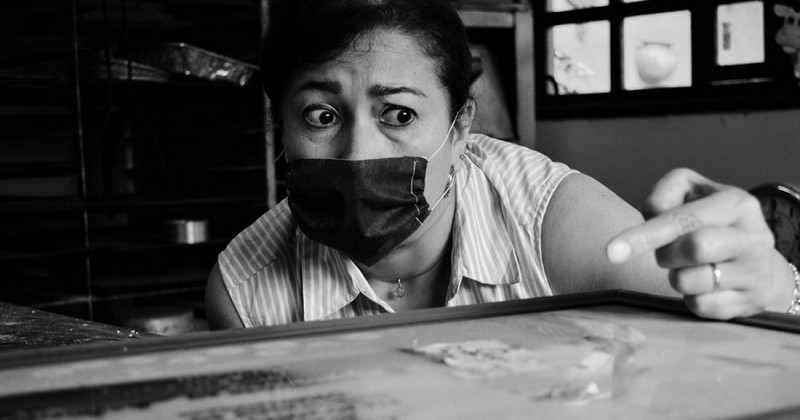Fear of dust and dirt: Causes and symptoms of fear of dust and dirt.

A very common fear that, in some severe cases, can be disabling.
Few sensations are as distressing and distressing as fear, which can manifest itself in the presence of real or imagined danger. Fear occurs when a stressful stimulus causes the release of a series of substances that cause the heart to race, breathing to increase and the body to prepare for the fight-flight response.
Although fear is an adaptive response, it can sometimes cause great suffering to the person who suffers from it. Especially when the fear is not real and manifests itself over and over again.
In this article we will talk about a phobic disorder called amatophobia.. That is to say, irrational fear to the dust and the dirt.
What are phobias
Phobias are irrational and pathological fears that cause great suffering to the person who suffers them. They are included within anxiety attacks, because their main symptom, in addition to fear, is the anxiety and anguish that the person experiences. Phobias cause the phobic individual to avoid the stimulus that causes discomfort.
When we talk about phobic disorders there are three types of phobias. Agoraphobia, which is an irrational fear that is characterized by the sufferer's fear of being in situations where he/she will not be able to receive help in a crisis. Social phobia is a disorder (or disorders) that appear in social interaction with other people, for example, erythrophobia or the fear of blushing. Finally, specific phobias are those that develop when faced with a specific object or being. For example, arachnophobia or fear of spiders, coulrophobia or fear of clowns or amatophobia or fear of dust, which we will discuss in more detail in the following lines.
Causes of amatophobia
Amatophobia is the persistent and irrational fear of dust and dirt. Like any phobia, it provokes the avoidance of the feared stimulus and high levels of anxiety.. It can affect the normality of an individual's life since dust can appear anywhere. For example, in one's own home.
Among the most frequent causes we can find.....
1. Traumatic experience
Traumatic experiences can be the origin of a phobia, due to classical conditioning, a person can learn to be afraid of a harmless stimulus due to the association that occurs when two stimuli are presented simultaneously. Classical conditioning became popular thanks to John Watson's experiments. To learn more about classical conditioning, you can read our article: "Classical conditioning and its most important experiments".
Due to the intense emotions that people can experience, a single traumatic incident can cause a person to develop this pathology, a single traumatic incident can cause a person to develop this pathology..
2. Observational learning
But traumatic experiences are not the only cause of this disorder, and an individual does not have to experience classical conditioning on his own skin. It is enough that he observes another person experiencing the traumatic event, by a phenomenon called vicarious conditioning. In the case of amatophobia, watching a movie in which a toxic dust appears can trigger the development of this disorder.
3. Biological predisposition
Phobia experts state that human beings are biologically predisposed to experience irrational fears, since the emotion of fear is adaptive and does not usually respond to logical arguments. This occurs because it has its origin in primitive and non-cognitive associations.
Symptoms of this disorder
Phobias belong to the group of anxiety disorders, since anxiety is one of the characteristic symptoms, as is fear.
When the phobia develops the phobic subject experiences cognitive symptoms, such as anguish, catastrophic thoughts, irrational fear or daze.. Behavioral symptoms also appear. For example, the attempt to avoid the feared stimulus. Finally, physical and physiological symptoms such as hyperventilation, pulse acceleration or chest tightness are also frequent.
Treatment
Anxiety disorders and, in particular, phobias, have been scientifically studied on multiple occasions. According to many research data, psychological therapy seems to be very effective.
There are many types of therapy, but for the treatment of phobic disorders, cognitive behavioral therapy is usually used, which applies different methods such as relaxation techniques or exposure techniques.
In fact, one technique that is ideal for treating phobias is systematic desensitization, which consists of exposing the patient to the phobic disorder.which consists of exposing the patient to the phobic stimulus gradually while learning different coping strategies such as relaxation techniques.
- If you want to know how this technique works, you only have to read our article: "What is systematic desensitization and how does it work?"
New therapies to treat phobias
In addition to cognitive behavioral therapy, other therapeutic models that have proven to be effective have also been used in recent years.. Two in particular stand out, cognitive therapy based on Mindfulness or acceptance and commitment therapy, both belonging to what are known as third generation therapies or contextual therapies.
In addition, thanks to new technologies, therapies with virtual reality are being applied, which expose the patient to the phobic stimulus without the need for it to be present. With the technological advance of smartphones, it is possible to find this tool in some apps.
- If you want to learn more about this topic, you can read our article: "8 apps to treat phobias and fears from your smartphone".
(Updated at Apr 12 / 2024)